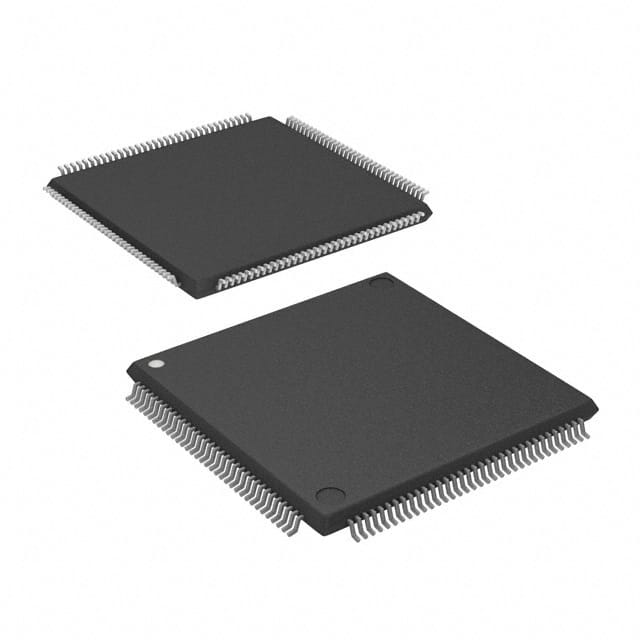Consulte las especificaciones para obtener detalles del producto.

EP2C8T144I8
Product Overview
Category: Integrated Circuit (IC)
Use: EP2C8T144I8 is a programmable logic device (PLD) that belongs to the Cyclone II family of Field-Programmable Gate Arrays (FPGAs). It is designed for various applications in digital logic design, including but not limited to embedded systems, telecommunications, industrial automation, and consumer electronics.
Characteristics: - High-performance FPGA with 8,064 logic elements - 144-pin Thin Quad Flat Pack (TQFP) package - Low power consumption - Flexible and reconfigurable design - Support for various I/O standards - On-chip memory blocks for efficient data storage - Built-in PLLs for clock management
Package and Quantity: The EP2C8T144I8 FPGA is available in a 144-pin TQFP package. Each package contains one unit of the FPGA.
Essence: EP2C8T144I8 is a key component in digital circuit design, providing a versatile and customizable platform for implementing complex logic functions.
Packaging/Quantity: The EP2C8T144I8 FPGA is packaged in a 144-pin TQFP package. Each package contains one unit of the FPGA.
Specifications
- Logic Elements: 8,064
- Memory Blocks: 270
- Maximum User I/Os: 119
- Maximum User Flash Memory: 281,600 bits
- Maximum User RAM: 414,720 bits
- Maximum Clock Frequency: 250 MHz
- Operating Voltage: 1.2V
- Operating Temperature Range: -40°C to 100°C
Detailed Pin Configuration
The EP2C8T144I8 FPGA has a total of 144 pins, each serving a specific purpose in the circuit design. The pin configuration includes dedicated input/output pins, clock pins, power supply pins, and configuration pins. For a detailed pinout diagram and description, refer to the manufacturer's datasheet.
Functional Features
- High-density programmable logic elements for implementing complex digital circuits.
- Flexible I/O standards support, allowing seamless integration with various external devices.
- On-chip memory blocks enable efficient data storage and retrieval.
- Built-in PLLs provide clock management capabilities, ensuring precise timing control.
- Reconfigurable design allows for easy modification and adaptation of the FPGA functionality.
- Low power consumption ensures energy efficiency in applications.
Advantages and Disadvantages
Advantages: - Versatile and customizable platform for digital circuit design. - High-performance FPGA with a large number of logic elements. - Support for various I/O standards enhances compatibility. - On-chip memory blocks and PLLs improve overall system efficiency. - Reconfigurable design enables flexibility in adapting to changing requirements.
Disadvantages: - Limited maximum user I/O count compared to higher-end FPGAs. - Relatively smaller user flash memory and RAM capacity. - Higher cost compared to simpler programmable logic devices.
Working Principles
The EP2C8T144I8 FPGA operates based on the principles of reconfigurable digital logic. It consists of an array of programmable logic elements interconnected through configurable routing resources. These logic elements can be programmed to implement desired logic functions, enabling the FPGA to perform complex computations and data processing tasks. The configuration of the FPGA is stored in non-volatile memory and can be modified as per the application requirements.
Detailed Application Field Plans
The EP2C8T144I8 FPGA finds extensive applications in various fields, including:
- Embedded Systems: Used for designing custom hardware accelerators, interface controllers, and real-time signal processing units in embedded systems.
- Telecommunications: Employed in the development of high-speed data communication systems, network routers, and protocol converters.
- Industrial Automation: Utilized for implementing control systems, motor drives, and sensor interfaces in industrial automation applications.
- Consumer Electronics: Integrated into consumer electronic devices such as gaming consoles, multimedia players, and smart home appliances to enable advanced functionalities.
Detailed and Complete Alternative Models
- EP2C5T144I8: A lower-density variant with 5,136 logic elements, suitable for smaller-scale applications.
- EP2C20F484C7: A higher-density FPGA with 19,728 logic elements and additional features like built-in flash memory and more I/O pins.
- EP4CE115F29C7: A more advanced FPGA from the Cyclone IV family, offering 114,480 logic elements and enhanced performance capabilities.
These alternative models provide different options based on the specific requirements of the application, allowing designers to choose the most suitable FPGA for their projects.
Word count: 623 words
Enumere 10 preguntas y respuestas comunes relacionadas con la aplicación de EP2C8T144I8 en soluciones técnicas
Sure! Here are 10 common questions and answers related to the application of EP2C8T144I8 in technical solutions:
Q: What is EP2C8T144I8? A: EP2C8T144I8 is a specific model number for an FPGA (Field-Programmable Gate Array) chip manufactured by Intel.
Q: What is the purpose of EP2C8T144I8 in technical solutions? A: EP2C8T144I8 is used as a programmable logic device that allows engineers to implement custom digital circuits and designs.
Q: What are some typical applications of EP2C8T144I8? A: EP2C8T144I8 can be used in various applications such as embedded systems, industrial automation, signal processing, robotics, and telecommunications.
Q: How does EP2C8T144I8 differ from other FPGA models? A: EP2C8T144I8 has specific characteristics like its capacity, speed, and I/O capabilities that differentiate it from other FPGA models.
Q: Can EP2C8T144I8 be reprogrammed after deployment? A: Yes, EP2C8T144I8 is a reprogrammable FPGA, allowing engineers to modify the design and functionality even after deployment.
Q: What tools are required to program EP2C8T144I8? A: To program EP2C8T144I8, you would typically use development software provided by Intel, such as Quartus Prime.
Q: Are there any limitations to consider when using EP2C8T144I8? A: EP2C8T144I8 has limited resources, including logic elements, memory blocks, and I/O pins. These limitations should be considered during design.
Q: Can EP2C8T144I8 interface with other components or devices? A: Yes, EP2C8T144I8 can interface with various components and devices through its I/O pins, allowing communication and integration with external systems.
Q: What programming languages are commonly used with EP2C8T144I8? A: VHDL (Very High-Speed Integrated Circuit Hardware Description Language) and Verilog are the most commonly used hardware description languages for programming EP2C8T144I8.
Q: Are there any development boards available for prototyping with EP2C8T144I8? A: Yes, Intel provides development boards like the DE10-Lite, which include the EP2C8T144I8 FPGA chip, allowing engineers to prototype and test their designs.
Please note that the answers provided here are general and may vary depending on specific requirements and applications.

